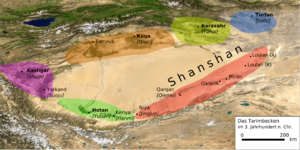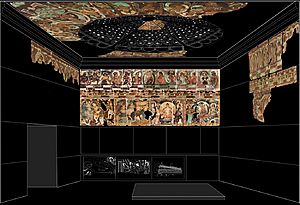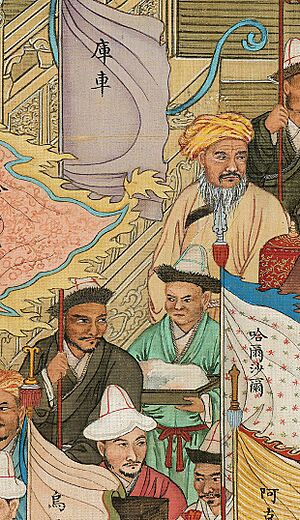Kucha facts for kids
Quick facts for kids
Kucha
龜茲
|
|||||||
|---|---|---|---|---|---|---|---|
| 2nd century BCE–648 CE | |||||||
| Lua error in Module:Location_map at line 420: attempt to index field 'wikibase' (a nil value).
Tarim Basin in the 3rd century
|
|||||||

Location of Kucha within Xinjiang with the county of Kucha in pink and the prefecture of Aksu in yellow
|
|||||||
| Religion | Buddhism | ||||||
| Demonym(s) | Kuchean | ||||||
| History | |||||||
|
• Established
|
2nd century BCE | ||||||
|
• Conquered by the Tang dynasty
|
648 CE | ||||||
| Population | |||||||
|
• 111 CE
|
81,317 | ||||||
| Currency | Kucha coinage | ||||||
|
|||||||
| Today part of | China | ||||||
Kucha (also spelled Kuche) was an ancient Buddhist kingdom. It was located on a branch of the famous Silk Road. This important trade route ran along the northern edge of the Taklamakan Desert in the Tarim Basin. Kucha was south of the Muzat River.
Today, the area where Kucha once stood is part of Aksu Prefecture, Xinjiang, China. The town of Kuqa is the main town of Kuqa County. In 1990, about 74,632 people lived there.
What's in a Name?
The name Kucha has changed a bit over time. In Turkic languages, it was called Kuchar. In modern Chinese, it's Kuché. These names are all linked to the older name Kushan from ancient times.
Ancient Chinese writings from the Han and Tang dynasties suggest the original name was Küchï. Other old records, like the Tibetan Annals from 687 CE, mention Guzan or Küsan. Later, during the Mongol Empire, people used names like Küsän or Güsän.
Even in the 16th century, names like Kūsān, Kūs, Kos, and Kujar were used for what is now Kucha.
Kucha's History
An Important Silk Road Kingdom
For a long time, Kucha was the biggest oasis city in the Tarim Basin. It was a major city in Central Asia and a key part of the Silk Road trade network. This meant Kucha was connected to many other cultures. It traded with places like Sogdia and Bactria, and also with cultures from South Asia, Iran, and China.
The main people living in Kucha were called Tocharians. They spoke an Indo-European language known as Kuchean Tocharian. These Tocharians are thought to be linked to an older group of people called the Afanasievo culture. Chinese records from the 2nd century BCE even described people with blue eyes and red hair in the area.
A Chinese official named Zhang Qian visited Central Asia in the 2nd century BCE. He stopped in Kucha during his travels. Chinese stories also tell of Princess Xijun, a Han princess. She was supposed to marry the king of the Wusun. But on her way, she stopped in Kucha and decided to marry the king of Kucha instead!
According to the Book of Han (finished in 111 CE), Kucha was the largest of the "Thirty-six Kingdoms of the Western Regions". It had a population of 81,317 people, with 21,076 who could fight. Kucha's location on the Northern Silk Road made it very rich and a center for trade and culture.
Rivalry and Chinese Control

During the Eastern Han dynasty (25–220 CE), Kucha and the whole Tarim Basin became a battleground. The Xiongnu from the north and the Han Chinese from the east both wanted control. In 74 CE, Chinese troops began taking over the Tarim Basin. Kucha first resisted China and allied with the Xiongnu. Even the Kushan Empire sent an army to help Kucha, but they soon left.
In 124 CE, Kucha officially joined the Chinese side. By 127 CE, China had taken control of the entire Tarim Basin. Kucha became part of China's Western Protectorate. This Chinese control of the Silk Road helped art and Buddhism spread from Central Asia. Famous travelers like the Roman Maes Titianus and many Buddhist missionaries visited the area. Around 150 CE, Chinese power in the west weakened, and the city-states of the Tarim Basin became independent again.
Kucha's Golden Age (4th-5th Centuries)
Kucha became very powerful and wealthy in the late 300s CE. It started to control most of the trade along the Silk Road. According to an old Chinese book called the Jinshu, Kucha was a strong city. It had a beautiful royal palace and many Buddhist temples:
There are fortified cities everywhere, their ramparts are three-fold, inside there are thousands of Buddhist stupas and temples (...) The royal palace is magnificent, glowing like a heavenly abode".
Culture thrived in Kucha. A famous Kuchean monk and translator named Kumarajiva (344–413 CE) translated Indian Sanskrit writings. He was the son of a man from Kashmir and a Kuchean mother.
The southern kingdoms of Shanshan and Jushi Kingdom (now Turfan) asked China for help against Kucha. A Chinese general named Lü Guang was sent by Emperor Fu Jian in 383 CE. Lü Guang conquered Kucha. He noted that Kucha soldiers had strong armor, like Sasanian chainmail and lamellar armour. This armor can also be seen in paintings at the Kizil Caves.
Kucha in the 6th Century
Ambassadors from Kucha visited the Chinese court of Emperor Yuan of Liang in his capital Jingzhou between 516 and 520 CE. An image of a Kucha ambassador is shown in a painting called Portraits of Periodical Offering of Liang.
The famous Chinese traveler Xuanzang visited Kucha in the 630s. He described Kucha in detail:
The soil is suitable for rice and grain... it produces grapes, pomegranates and numerous species of plums, pears, peaches, and almonds... The ground is rich in minerals-gold, copper, iron, and lead and tin. The air is soft, and the manners of the people honest. The style of writing is Indian, with some differences. They excel other countries in their skill in playing on the lute and pipe. They clothe themselves with ornamental garments of silk and embroidery...
There are about one hundred convents in this country, with five thousand and more disciples. These belong to the Little Vehicle of the school of the Sarvastivadas. Their doctrine and their rules of discipline are like those of India, and those who read them use the same originals... About 40 li to the north of this desert city there are two convents close together on the slope of a mountain... Outside the western gate of the chief city, on the right and left side of the road, there are erect figures of Buddha, about 90 feet high.

Kucha also developed a special style of music. "Kuchean" music became very popular as it spread along the Silk Road. You can see lively scenes of Kuchean music and dancing in the Kizil Caves paintings. Xuanzang also wrote about them. Kuchean music was especially popular in Tang China. The lute, a stringed instrument, became known in Chinese as the pipa. Kuchean music also traveled from China to Japan and is still preserved there as gagaku, or Japanese court music.
Later History (7th to 13th Centuries)
After the Tang dynasty conquered Kucha in the early 7th century, it became one of the "Four Garrisons of Anxi" (meaning "Pacified West"). It was even considered the capital of this region.
For a few decades in the late 600s, the Tibetan Empire controlled Kucha. But Kucha was usually at least partly independent.
In the 8th and 9th centuries, Uyghurs started moving into the area. After the Uyghur Khaganate was destroyed in 840, Kucha became an important center for the Uyghur kingdom of Qocho.
The large ruins of the old capital and the Subashi Temple (also called Qiuci) are about 20 kilometers (12 miles) north of modern Kucha. This temple was abandoned in the 13th century.
Modern Kucha
In 1887, Francis Younghusband traveled through Kucha. He estimated the district had about 60,000 people. The Chinese town was about 700 square yards (585 square meters) with a 25-foot (7.6-meter) high wall. There were also remains of an older city.
Today, Kucha is part of Kuqa, Xinjiang. It has a new city area with a People's Square and transportation hub. There's also an old city with a Friday market and parts of the old city wall and cemetery. Besides farming, Kucha also makes cement, carpets, and other goods in its local factories.
Exploring Ancient Kucha
Several important archaeological sites in the Kucha region have been studied. German expeditions in the early 1900s explored places like Achik-Ilek and Subashi, which are very close to Kucha.
Kucha and Buddhism
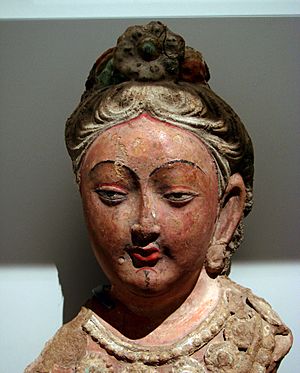
Kucha was a very important center for Buddhism from ancient times until the late Middle Ages. Buddhism arrived in Kucha before the end of the 1st century. However, it wasn't until the 4th century that the kingdom became a major Buddhist center. It mainly followed the Sarvastivada school of Buddhism. Later, during the Uyghur period, Mahayana Buddhism also became important. This was different from Khotan, another kingdom that was mostly Mahayana Buddhist.
According to the Book of Jin, in the 3rd century, Kucha had nearly a thousand Buddhist stupas (dome-shaped structures) and temples. Around this time, monks from Kucha began traveling to China. In the 4th century, Buddhism grew even more in the kingdom. The royal palace was said to look like a Buddhist monastery, with carved stone Buddhas. Many monasteries were built around the city.
Kucha is especially famous as the home of the great 5th-century monk and translator, Kumārajīva (344–413 CE).
Famous Monks from Kucha
Po-Yen
A monk from the royal family, known as Boyan, traveled to the Chinese capital, Luoyang, between 256 and 260 CE. In 258 CE, he translated six Buddhist texts into Chinese at China's famous White Horse Temple. One of these was the Longer Sukhāvatīvyūha Sūtra, an important text in Pure Land Buddhism.
Po-Śrīmitra
Po-Śrīmitra was another monk from Kucha. He traveled to China between 307 and 312 CE and translated three Buddhist texts.
Po-Yen (Second Monk)
A second Buddhist monk from Kucha, also named Po-Yen, went to Liangzhou (modern Wuwei, Gansu, China). He was highly respected, though he is not known to have translated any texts.
The Tocharian Languages
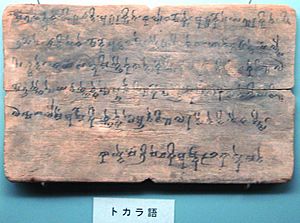
The language spoken in Kucha was called Kuśiññe (Kushine). It's also known as Tocharian B or West Tocharian. This language belongs to the Indo-European family, like English or Spanish. Later, when the Uyghurs took control, the Kingdom of Kucha gradually started speaking Turkic.
Kuśiññe was completely forgotten until the early 20th century. That's when writings and documents in two related Tocharian languages were found in the Tarim Basin. These languages were written using a Central Asian Brahmi script. What's interesting is that Tocharian languages belong to the "centum group" of Indo-European languages. Most languages in this group are found in Southern and Western Europe.
The exact age of known Tocharian texts is debated, but they were written around the 6th to 8th centuries CE. However, people speaking Tocharian must have arrived in the region much earlier. Both languages died out before about 1000 CE. Scholars are still trying to learn more about these languages, where they came from, and how they are connected.
Kucha's Neighbors
The kingdom of Kucha shared borders with Aksu and Kashgar to the west. To the east, it bordered Karasahr and Turpan. Across the Taklamakan Desert to the south was the kingdom of Khotan.
Kucha and the Kizil Caves
The Kizil Caves are about 70 kilometers (43 miles) northwest of Kucha. They were part of the rich kingdom of Kucha in the 4th century. A local legend says the caves were started by the royal family of ancient Kucha. It tells of Princess Zaoerhan, the daughter of the King of Kucha. She fell in love with a local mason.
The king was against their marriage. He told the mason he could only marry the princess if he carved 1,000 caves into the nearby hills. The determined mason worked for three years, carving 999 caves. But he died from exhaustion before finishing. The heartbroken princess found his body and grieved until she also died. People say her tears are now the waterfalls that flow down some of the cave's rock faces.
Kucha's Coins
Around the 3rd or 4th century, Kucha started making its own Wu Zhu (五銖) cash coins. These coins were inspired by the smaller, less valuable Wu Zhu coins made in China after the Han dynasty. It's likely that Kucha's coins were made before the Kaiyuan Tongbao coins. The making of Kucha's own coins probably stopped sometime after 621 CE, when Wu Zhu coins were no longer used in China.
Kucha's coins include the "Han Qiu bilingual Wu Zhu coin" (漢龜二體五銖錢). This coin has writing in both Chinese and a language from Kucha, which scholars are still trying to understand.
Important Dates
- 630 CE: The Chinese monk Xuanzang visited the kingdom of Kucha.
Rulers of Kucha
(Names are based on modern Mandarin pronunciations from ancient Chinese records)
- Hong (弘) 16 CE
- Cheng De (丞德) 36 CE
- Ze Luo (則羅) 46 CE
- Shen Du (身毒) 50 CE
- Jiang Bin (絳賓) 72 CE
- Jian (建) 73 CE
- You Liduo (尤利多) 76 CE
- Bai Ba (白霸) 91 CE
- Bai Ying (白英) 110–127 CE
- Bai Shan (白山) 280 CE
- Long Hui (龍會) 326 CE
- Bai Chun (白純) 349 CE
- Bai Zhen (白震) 382 CE
- Niruimo Zhunashen (尼瑞摩珠那勝) 521 CE
- Bai Sunidie (白蘇尼咥) 562 CE
- Anandavarman ?
- Tottika (around 550–600 CE)
- Suvarnapushpa (白蘇伐勃駃 Bái Sūfábókuài) 600–625 CE
- Suvarnadeva (白蘇伐疊 Bai Sufadie) 625-645 CE
- Haripuspa (白訶黎布失畢, Bai Helibushibi) 647 CE
- Bai Yehu (白葉護) 648 CE
- Bai Helibushibi (白訶黎布失畢) 650 CE
- Bai Suji (白素稽) 659 CE
- Yan Tiandie (延田跌) 678 CE
- Bai Mobi (白莫苾) 708 CE
- Bai Xiaojie (白孝節) 719 CE
- Bai Huan (白環) 731–789? / Tang general – Guo Xin 789
See also
 In Spanish: Kucha para niños
In Spanish: Kucha para niños


